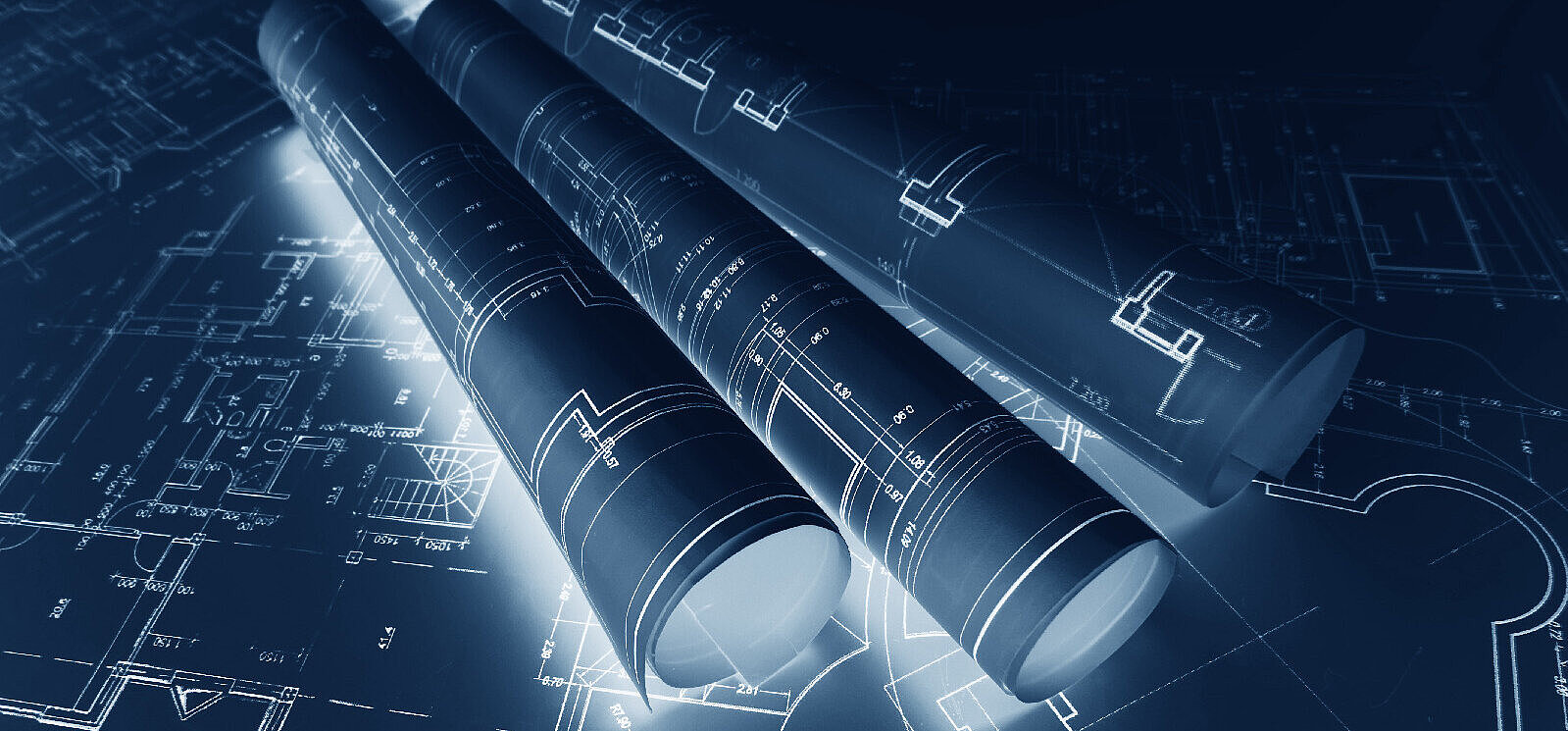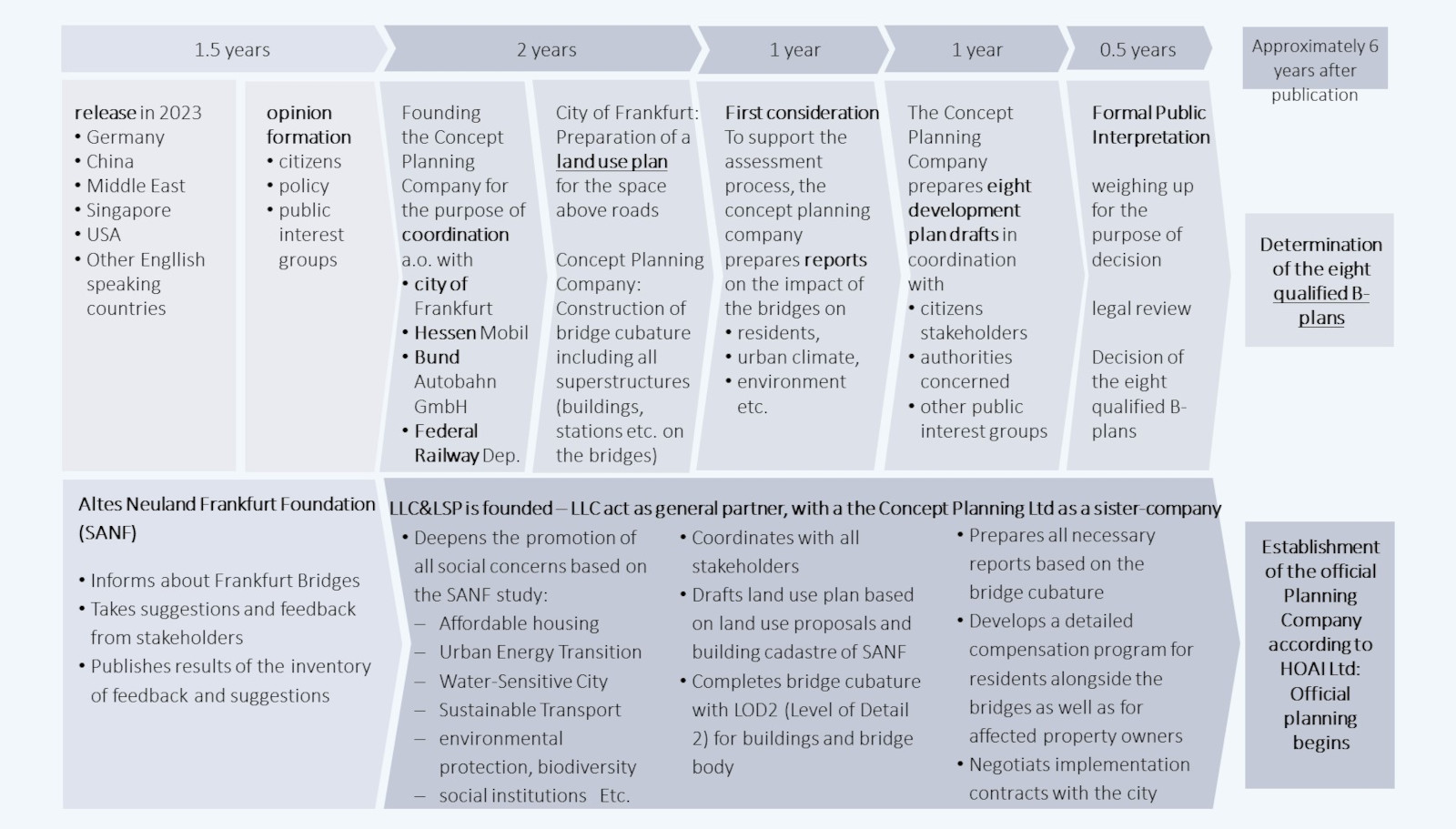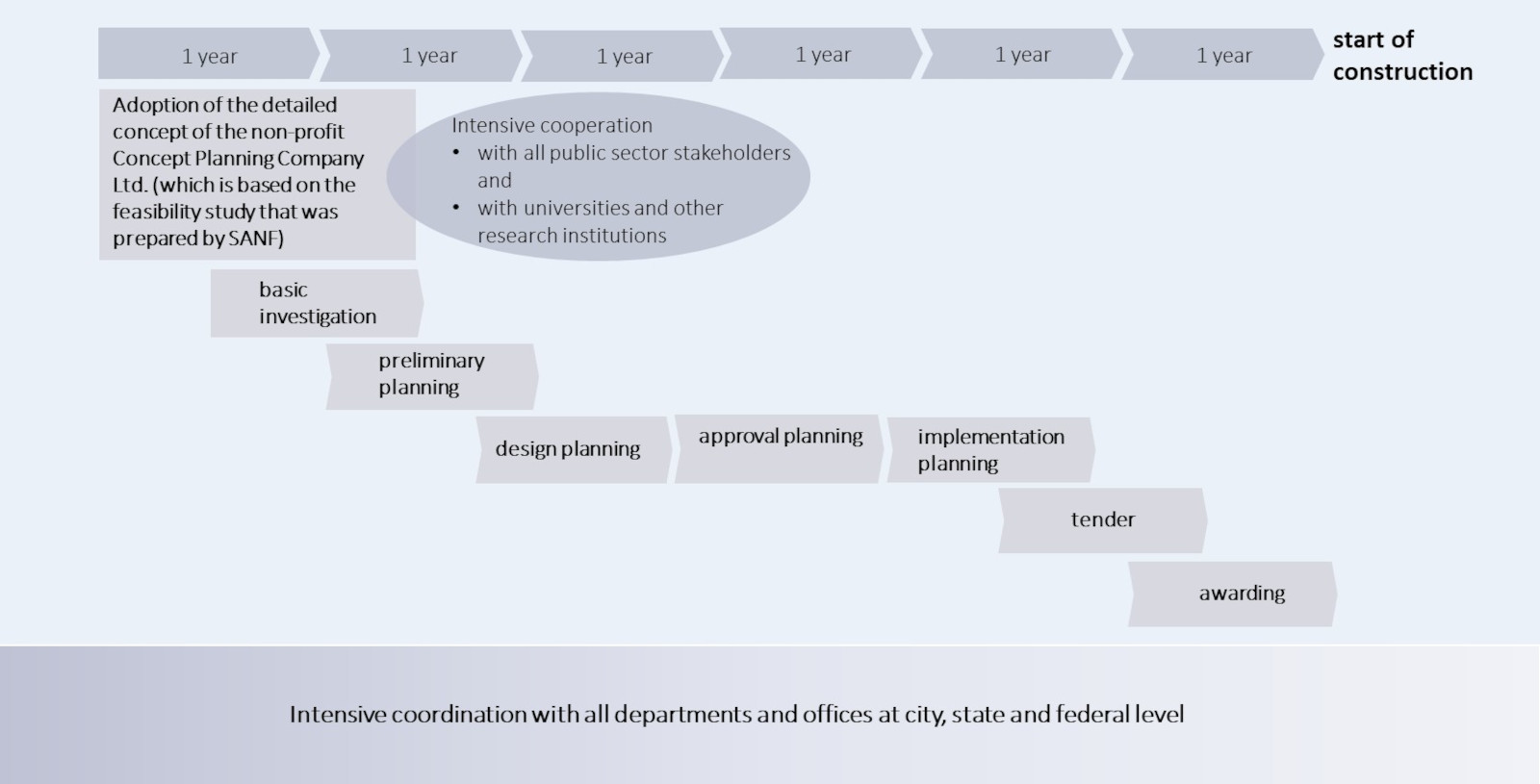
Just as the non-profit concept planning company has already developed 8 qualified B plans under social and ecological aspects, the construction company also works in a non-profit legal form
As a guarantee for the implementation of all plans in the interests of all stakeholders
The adoption of development plans for large-scale projects in Germany usually takes years and decades because the interests that are to be fulfilled by the large-scale project are often at the expense of nature, residents or other groups that are affected by the project. If the state is the sponsor of the large-scale project or is involved in it by investing in it, the awarding of the contract under European tendering law makes the process even more difficult. In the Frankfurt Bridges infrastructure project, these contradictions and problems are solved by the fact that (1) the investors are from the private sector, (2) the actors in planning, construction and operation belong to non-profit organizations and (3) before the actual start of planning according to HOAI, a concept planning phase of around 5 years is activated, which (a) works out the bridge and bridge building volume in such detail that residents and property owners know exactly what to expect (b) a very concrete compensation plan can be drawn up that comes into force when the B-plans are adopted (c) coordination with all stakeholders in the public sector can be carried out in such detail that no public law hurdles arise during the construction period.
In the lead time before the actual planning according to HOAI begins, a land use plan and eight development plans must be developed
In the lead time before the actual planning begins, a “small concept planning company” must be founded to develop a site plan and eight development plans – one development plan for the ring and one each for the seven bridge arms in Frankfurt.
The concept planning company should already have a non-profit legal form so that the social and environmental goals of the Frankfurt Bridges can be recorded in its foundation declaration of purpose in harmony with the interests of the investors.
The first step is intensive coordination between this small non-profit Concept Planning Company Ltd and the relevant institutions at city, state and federal level.
A land use plan can then be developed on the basis of the feasibility study by the non-profit foundation Stiftung Altes Neuland Frankfurt (SANF) in alignment with the results of the consultation with all institutions concerned.
As soon as the land use plan has been adopted, the non-profit Concept Planning Company Ltd will develop eight development plans ( so called B-Plans) separately from one another so that even if an objection is raised against one of them, the construction of all sections of the Frankfurt Bridges will not be halted until such an objection has been resolved.
In order to gain public acceptance, particularly in the streets affected by the bridges, the cubature of the bridges, including the cubature of all buildings on the bridges, must also be completed by the Concept Planning Company Ltd during this “lead time” phase (of about 4 to 5 years), so that all residents alongside the Frankfurt Bridges can get an idea of how the respective bridge section on their doorstep should look like.
Based on this cubature planning, the Concept Planning Company Ltd analyses the extent to which which of these residents will be shaded by the bridges. It then uses this as a basis to develop a compensation program that determines the amount or selection of compensation alternatives for affected residents or property owners per degree of shading. In this way, residents know in advance what compensation they can expect and what they will miss out on if the bridges are not built – the goal being to turn all residents alongside the bridges to fans of this large infrastructure projects instead of opponents.
Through intensive coordination and thorough preparatory work, legal safeguards are also provided in the preliminary phase to ensure that the social and urban development objectives of the construction project are achieved

Thanks to the preparatory work of the Altes Neuland Frankfurt Foundation, the project can be designed in comparatively detailed and thus concrete and transparent manner in the preliminary phase of 4 to 5 years by the Concept Planning Company Ltd.
Infrastructure projects usually take a long time to be approved because
- they entail an impairment of nature, the mitigation of which requires thorough advance planning and coordination
- Residents and property owners are usually the ones who suffer most and are not the primary beneficiaries of the new infrastructure at the same time
Both points are not an obstacle for the Frankfurt Bridges:
- The bridges are geared in all aspects towards nature conservation, species protection, rainwater use for greening, use of renewable energies, sustainable transport, sustainable packaging management and the improvement of the urban climate; they also have a high value for the environment through their research and exemplary character in terms of (a) reducing CO2 during construction as well as during operation (b) using excavated material to create biotopes and (c) structural integration of nesting and species protection elements already in the planning stage. All of the results from this can be applied to other infrastructure projects, which indirectly multiplies the nature and environmental protection character of the Frankfurt Bridges many times over.
- The residents and property owners alongside the Frankfurt Bridges benefit the most from the bridges, as they do not run through exclusive residential areas, but always over at least four-lane roads: With the bridges, the negative aspects of these wide roads on the doorstep are replaced by (a) a 24/7 transport connection to the rest of the city, which offers a station less than 200 meters away, so that places that were previously only accessible door to door by car suddenly become accessible (b) when looking out of the window, residents see an artistically designed structure with an artistic glass privacy screen along the bridges (c) there is significantly more greenery right on their doorsteps, either on along the bridges or for walking on the bridge surface. All in all, a previously less sought-after residential area suddenly becomes a prime residential area thanks to the location next to the bridge. For those residents who are shaded by the bridges on the ground floor or, in some cases, on the first floor, there is a compensation offer that must be designed so attractively that this stakeholder group becomes the biggest supporters of the Frankfurt Bridges - if only to benefit from the compensation.
Worldwide, the construction goals of large private investors and social or nature conservation goals often conflict with each other
In Germany, this contradiction often leads to extremely long planning and construction times, which makes the projects unattractively expensive: objections to the development plans, resistance during the planning approval process, and even objections with interim injunctions allegedly due to impairment of personal property rights - the entire range of building law can be played to make infrastructure projects extremely lengthy or, in some cases, even prevent them, even at a late development stage. The Frankfurt Bridges as a showcase for innovations are intended to eliminate this contradiction by ensuring that the majority of the return on investment only occurs in 100 years, so that social goals meet the target structure of the investors. It is in both their interest
- that no delay in planning and construction occurs due to legal resistance
- that the investment is of such good quality that it will bring the expected return in 100 years – avoiding short-term profit optimization on the cost of quality
- that the investment can automatically increase in value from year to year during the term and that fund-shares remain fungible and become successively more valuable the closer the final payout comes.
The traditional conflicts of interests can only be resolved if the profit interests of investors and the social goals of the public are brought to a common denominator - ideally by having the entire project carried out by non-profit organizations.
Especially in the legally critical planning phase of approving the development plans, it is important that the acceptance of the project among the public and affected residents is increased by the non-profit nature of the planning company, as this is a guarantee that social and environmental goals are given top priority in the planning and are adhered to.

The planning process is designed to be as efficient and effective as possible: in the case of construction planning law, this will be assured by non-profit actors with social goals
And in the case of building regulations, by intensive coordination already in the preliminary phase with all those involved in the public sector
Coordination with all public sector stakeholders is not only carried out to ensure that dangers are averted, but also to ensure compliance with other legal provisions and to incorporate innovative aspects into them. Legal provisions are constantly being revised and updated, anyway.
Since research and science are involved in the Frankfurt Bridges construction project from the very beginning, well-founded suggestions for amending regulations can be taken up by the Frankfurt Bridges Planning Company and coordinated with offices and supervisory authorities.
In addition, the Frankfurt Bridges can be considered as special structures and therefore not only are special hubs implemented on them with a view to achieving their social objectives (e.g. women’s shelter, housing for the homeless etc.), but due to so many positive impacts of the bridges on the city, concessions can also be permitted in the interest of the general public.
The actual planning phase according to HOAI lasts five to six years – coordination with all public sector stakeholders is the biggest lever for a successful construction phase in which cost and time frames are adhered to
